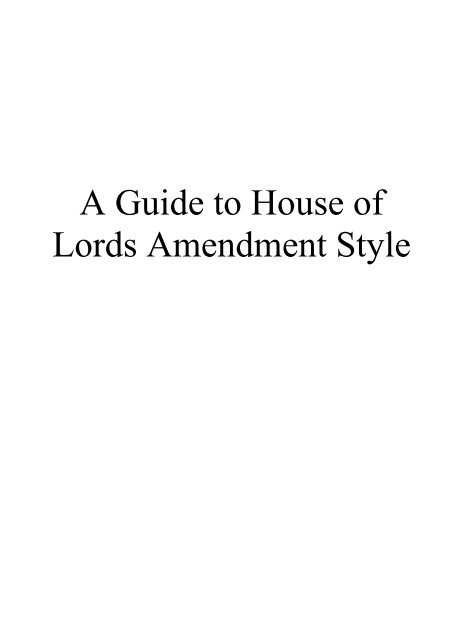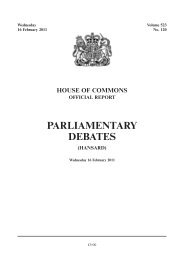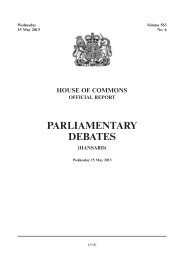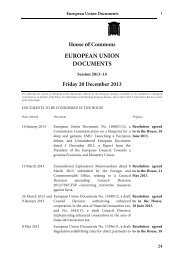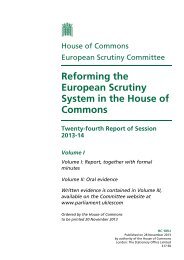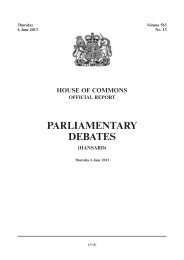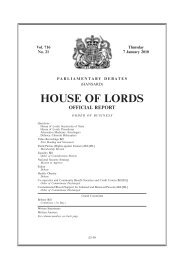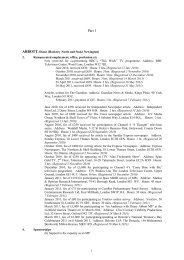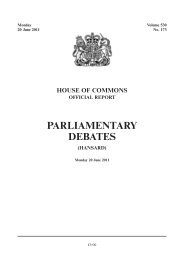Guide to House of Lords amendment style
Guide to House of Lords amendment style
Guide to House of Lords amendment style
You also want an ePaper? Increase the reach of your titles
YUMPU automatically turns print PDFs into web optimized ePapers that Google loves.
A <strong>Guide</strong> <strong>to</strong> <strong>House</strong> <strong>of</strong><br />
<strong>Lords</strong> Amendment Style
This booklet sets out the various categories <strong>of</strong> <strong>amendment</strong>s with examples <strong>of</strong> the most common<br />
variations. (It does not cover motions and <strong>amendment</strong>s moved on consideration <strong>of</strong> Commons<br />
Amendments, Reasons etc.). It is designed <strong>to</strong> assist members <strong>of</strong> the <strong>House</strong> and their advisers in<br />
drafting <strong>amendment</strong>s in proper form and reflects recent changes made in the layout <strong>of</strong> statute.<br />
Points <strong>of</strong> procedure and rules <strong>of</strong> admissibility relating <strong>to</strong> <strong>amendment</strong>s are set out in “Taking<br />
Part in Public Bills in the <strong>House</strong> <strong>of</strong> <strong>Lords</strong>”, published by the Public Bill Office, and in the<br />
“Companion <strong>to</strong> Standing Orders”. Both are available in the Printed Paper Office.<br />
Public Bill Office staff are available <strong>to</strong> advise on <strong>amendment</strong>s and if required will edit any text<br />
received.<br />
Members or their advisers who intend <strong>to</strong> table a large number <strong>of</strong> <strong>amendment</strong>s are encouraged <strong>to</strong><br />
use the <strong>amendment</strong> pr<strong>of</strong>orma available from this <strong>of</strong>fice in paper or electronic form.<br />
Amendments may be tabled between 10.00 am and 5.00 pm (4.00 pm on Friday). They must be<br />
signed by the member who wishes <strong>to</strong> table them. They may be handed in <strong>to</strong> the <strong>of</strong>fice or faxed.<br />
Telephone: 020 7219 3153<br />
Fax: 020 7219 5933<br />
Public Bill Office<br />
April 2002
Contents<br />
(1) AMENDMENTS TO LEAVE OUT<br />
(2) AMENDMENTS TO LEAVE OUT AND INSERT<br />
(3) AMENDMENTS TO INSERT<br />
(4) AMENDMENTS TO DIVIDE OR TRANSPOSE CLAUSES OR SCHEDULES<br />
(5) AMENDMENTS TO THE LONG TITLE<br />
(6) AMENDMENTS TO AMENDMENTS<br />
(7) AMENDMENTS IN SUBSTITUTION<br />
(8) AMENDMENTS TO TEXT IN COLUMNS<br />
(9) SUBDIVISIONS OF CLAUSES AND SCHEDULES: AN ILLUSTRATION
(1) AMENDMENTS TO LEAVE OUT<br />
1. Amendments <strong>to</strong> leave out Clauses or Schedules<br />
NB: Separate <strong>amendment</strong>s are required <strong>to</strong> leave out more than one Clause or Schedule<br />
(a) Committee Stage<br />
NB: At Committee Stage <strong>amendment</strong>s <strong>to</strong> leave out Clauses or Schedules take the form <strong>of</strong><br />
opposition <strong>to</strong> the motion that each Clause or Schedule “stand part” <strong>of</strong> the bill, and are<br />
tabled as “ italic notices” <strong>of</strong> opposition. Strictly speaking, they are not <strong>amendment</strong>s. But<br />
they may have up <strong>to</strong> the usual four names (or four plus the member-in-charge) as<br />
signa<strong>to</strong>ries.<br />
Clause 2<br />
THE LORD SMITH<br />
[THE LORD ADDITIONAL-NAME]<br />
The Lord Smith gives notice <strong>of</strong> his intention <strong>to</strong> oppose the Question that Clause 2 stand part <strong>of</strong><br />
the Bill.<br />
[The above-named <strong>Lords</strong> give notice <strong>of</strong> their…..]<br />
Schedule 3<br />
THE BARONESS JONES<br />
[THE BARONESS ADDITIONAL-NAME]<br />
The Baroness Jones gives notice <strong>of</strong> her intention <strong>to</strong> oppose the Question that Schedule 3 be the<br />
Third Schedule <strong>to</strong> the Bill.<br />
[The above-named <strong>Lords</strong> give notice <strong>of</strong> their…..]<br />
(b) Report and Third Reading<br />
Leave out Clause 2<br />
Leave out Schedule 3
2. Amendments <strong>to</strong> leave out whole subsections (or any whole subdivision <strong>of</strong> a Clause or<br />
Schedule)<br />
NB: For subdivisions <strong>of</strong> text inserted in<strong>to</strong> previous Acts see 3.<br />
In a Clause:<br />
Page 2, line 10, leave out subsection (1)<br />
Page 2, line 10, leave out subsections (1) and (2)<br />
Page 2, line 10, leave out subsections (1) <strong>to</strong> (4)<br />
Page 2, line 12, leave out paragraph (a)<br />
Page 2, line 13, leave out sub-paragraph (i)<br />
In a Schedule:<br />
Page 100, line 14, leave out paragraph 1<br />
Page 100, line 18, leave out sub-paragraph (1)<br />
3. Amendments <strong>to</strong> leave out lines<br />
NB: This form is applied <strong>to</strong> any block <strong>of</strong> text consisting <strong>of</strong> whole lines (other than a<br />
complete subdivision <strong>of</strong> a Clause or Schedule) and any subdivision <strong>of</strong> text inserted in<strong>to</strong> a<br />
previous Act.<br />
Page 2, leave out line 10<br />
Page 2, leave out lines 10 and 11<br />
Page 2, leave out lines 10 <strong>to</strong> 14<br />
Page 2, leave out from beginning <strong>of</strong> line 10 <strong>to</strong> end <strong>of</strong> line 2 on page 3
4. Amendments <strong>to</strong> leave out text not consisting <strong>of</strong> whole lines<br />
(a) Leave out from “x” <strong>to</strong> “y”<br />
NB: Use the form “leave out from “x” <strong>to</strong> “y”” where the words <strong>to</strong> be left out number more<br />
than eight. Remember that the words “x” and “y” are the words before and after the words<br />
<strong>to</strong> be left out and will stay in the bill.<br />
Page 2, line 10, leave out “(3),”<br />
Page 2, line 10, leave out “, or the Direc<strong>to</strong>r (or his deputy),<br />
Page 2, line 10, leave out from beginning <strong>to</strong> “decide” in line 12<br />
Page 2, line 10, leave out from beginning <strong>to</strong> “the” in line 3 on page 3<br />
Page 2, line 10, leave out from “State” <strong>to</strong> end <strong>of</strong> line 12<br />
Page 2, line 10, leave out from “State” <strong>to</strong> “shall” in line 11<br />
(b) Leave out “words”<br />
Page 2, line 10, leave out “after consultation with the relevant bodies”
(2) AMENDMENTS TO LEAVE OUT AND INSERT<br />
1. Amendments <strong>to</strong> leave out Clauses or Schedules and insert new Clauses or Schedules<br />
Leave out Clause 5 and insert the following new Clause<br />
“Title <strong>of</strong> the new Clause<br />
(1) Text <strong>of</strong> new Clause set out if necessary in numbered subsections ((1), (2) etc), each<br />
consisting <strong>of</strong> a whole sentence and divided where appropriate in<strong>to</strong> paragraphs ((a),<br />
(b) etc) and sub-paragraphs ((i), (ii) etc).”<br />
Leave out Schedule 3 and insert the following new Schedule<br />
“SCHEDULE<br />
TITLE OF NEW SCHEDULE<br />
1 Text <strong>of</strong> new Schedule, set out if necessary in numbered paragraphs (1, 2, etc) and<br />
sub-paragraphs ((1), (2) etc; (a), (b) etc).”<br />
2. Amendments <strong>to</strong> leave out whole subsections (or any whole subdivision <strong>of</strong> a Clause or<br />
Schedule) and insert new subsections (paragraphs, etc.)<br />
Page 3, line 4, leave out subsection (2) and insert<br />
“(2) Where the Secretary <strong>of</strong> State […].”<br />
Page 3, line 4, leave out subsection (2) and insert<br />
“(2) Subsection (1) does not apply in the circumstances set out in subsection<br />
(2A) below.<br />
(2A)<br />
Those circumstances are<br />
(a) where […].”
3. Amendments <strong>to</strong> leave out lines and insert new text<br />
Page 4, leave out line 10 and insert<br />
“having regard <strong>to</strong> the different sec<strong>to</strong>rs <strong>of</strong> employment,”<br />
Page 104, leave out lines 10 <strong>to</strong> 14 and insert<br />
“This paragraph applies [….].”<br />
Page 12, leave out line 5 and insert “except where directed by the Treasury.”<br />
4. Amendments <strong>to</strong> leave out words and insert words<br />
Page 1, line 10, leave out “may” and insert “shall”<br />
Page 2, line 4, leave out “with the consent <strong>of</strong> the Treasury,” and insert “unless the Secretary<br />
<strong>of</strong> State otherwise directs,”<br />
Page 5, line 8, leave out “(4)(b), (5) or (6)” and insert “(4), (5) or (6)(a)”<br />
Page 10, line 24, leave out “may” and insert<br />
“(a) shall, if requested <strong>to</strong> do so by the Secretary <strong>of</strong> State, and<br />
(b) may, in any other case,”<br />
Page 12, line 12, leave out “except in Scotland” and insert “except where subsection (2A)<br />
applies.<br />
(2A) This subsection applies where […].”<br />
Page 14, line 40, leave out from second “the” <strong>to</strong> “for” in line 42 and insert “information<br />
sought shall be used only”<br />
Page 14, line 40, leave out from second “the” <strong>to</strong> end <strong>of</strong> line 2 on page 15 and insert<br />
“information sought shall be used only for the purposes set out in subsection (3) below.”
(3) AMENDMENTS TO INSERT<br />
1. Amendments <strong>to</strong> insert new Clauses or Schedules<br />
Insert the following new Clause<br />
“Title <strong>of</strong> the new Clause<br />
After Clause 3 / Before Clause 3<br />
(1) Clause with Text <strong>of</strong> a new subsections.<br />
(2) Second subsection with paragraphs<br />
(a) written out,<br />
(b) in order, and<br />
(c) with the following<br />
(i) first sub-paragraph, or<br />
(ii) further sub-paragraphs.<br />
(3) [….].”<br />
Insert the following new Clause<br />
After Clause 100<br />
“Title <strong>of</strong> a new Clause <strong>to</strong> insert a Clause in<strong>to</strong> another Act<br />
After section 24 <strong>of</strong> the Pensions Act 1985 (c. 99) there is inserted the<br />
following section<br />
“24A Disapplication <strong>of</strong> section 24<br />
(1) Section 24 above shall not apply in the circumstances set out in<br />
subsection (2) below.<br />
(2) Those circumstances are<br />
(a) that person concerned does not consent, or<br />
(b) that the court has made an order under section 25.”"
Insert the following new Schedule<br />
After Schedule 2<br />
“SCHEDULE<br />
TITLE OF NEW SCHEDULE<br />
1 Text <strong>of</strong> new Schedule, set out in numbered paragraphs, sub-paragraphs, etc.”<br />
NB: Any <strong>amendment</strong> <strong>to</strong> insert a new Schedule must be accompanied by a new Clause (or,<br />
if appropriate, a new subsection in an existing Clause) <strong>to</strong> give effect <strong>to</strong> the new Schedule.<br />
See the following example.<br />
After Clause 23<br />
Insert the following new Clause<br />
“New cross heading<br />
Clause title<br />
Schedule (Title <strong>of</strong> new Schedule) shall have effect.”<br />
2. Amendments <strong>to</strong> insert new subsections<br />
NB: A new subsection should normally be un-numbered unless numbering is required for<br />
cross-reference purposes. Subsections inserted between existing subsections (2) and (3)<br />
are numbered (2A), (2B) etc.; subsections added after subsection (3) if that is the last<br />
existing subsection may be numbered (4), (5) etc. The line number should refer <strong>to</strong> the line<br />
immediately preceding the point at which the new subsection is <strong>to</strong> be inserted.<br />
Page 2, line 10, at end insert<br />
“( ) An order under subsection (2) above shall not be made until a draft has<br />
been laid before both <strong>House</strong>s <strong>of</strong> Parliament and approved by resolution<br />
<strong>of</strong> each <strong>House</strong>.”
Page 4, line 38, at end insert<br />
"(2A)<br />
(2B)<br />
This section does not apply in the circumstances referred <strong>to</strong> subsection<br />
(2B) below.<br />
Those circumstances are [….].”<br />
3. Amendments <strong>to</strong> insert new paragraphs, sub-paragraphs etc.<br />
NB: New paragraphs should normally be un-numbered unless numbering is required for<br />
cross-reference purposes. Paragraphs inserted between existing paragraphs (b) and (c)<br />
are numbered (bb), (bc) etc.; paragraphs added after paragraph (c) if that is the last<br />
existing subsection may be numbered (d), (e) etc. The line number should refer <strong>to</strong> the line<br />
immediately preceding the point at which the new paragraph is <strong>to</strong> be inserted.<br />
Page 3, line 22, at end insert<br />
“( ) where the Secretary <strong>of</strong> State so directs,”<br />
Page 4, line 19, at end insert “; or<br />
( ) the Isle <strong>of</strong> Man”<br />
Page 35, line 2, at end insert<br />
“(iv) the Direc<strong>to</strong>r General, or<br />
(v) any person authorised by the Secretary <strong>of</strong> State <strong>to</strong> carry out the functions <strong>of</strong><br />
one <strong>of</strong> the persons referred <strong>to</strong> in sub-paragraphs (i) <strong>to</strong> (iv).”<br />
3. Amendments <strong>to</strong> insert words<br />
Page 5, line 35, after “Direc<strong>to</strong>r” insert “or his deputy”<br />
Page 5, line 35, after first “<strong>to</strong>” insert “his normal place <strong>of</strong> residence or”<br />
Page 5, line 40, at beginning insert “Subject <strong>to</strong> subsection (3A) below,”<br />
Page 5, line 45, at end insert “or (3)(b)”
(4) AMENDMENTS TO DIVIDE OR TRANSPOSE CLAUSES<br />
OR SCHEDULES<br />
Clause 24<br />
Divide Clause 24 in<strong>to</strong> two clauses, the first (Title <strong>of</strong> first new Clause) <strong>to</strong> consist <strong>of</strong> subsections<br />
(1) <strong>to</strong> (3) and the second (Title <strong>of</strong> second new Clause) <strong>to</strong> consist <strong>of</strong> subsections (4) <strong>to</strong> (6)<br />
Clause 24<br />
Transpose Clause 24 <strong>to</strong> after Clause 25
(5) AMENDMENTS TO THE LONG TITLE<br />
In the Title<br />
Line 5, leave out “; and for connected purposes”<br />
Line 3, leave out from “appeal” <strong>to</strong> first “<strong>to</strong>” in line 4<br />
Line 3, leave out “dangerous substances” and insert “pathogens and <strong>to</strong>xins”<br />
Line 3, after “appeal;” insert “<strong>to</strong> amend the law <strong>of</strong> trespass;”<br />
Line 5, at end insert “; and for connected purposes”
(6) AMENDMENTS TO AMENDMENTS<br />
Clause 3<br />
THE LORD SMITH<br />
[As an <strong>amendment</strong> <strong>to</strong> <strong>amendment</strong> 241]<br />
Line 2, leave out “or the Secretary <strong>of</strong> State”<br />
Clause 4<br />
THE LORD JONES<br />
[As an <strong>amendment</strong> <strong>to</strong> the [first] <strong>amendment</strong> [<strong>to</strong> page 2, line 4] printed on sheet<br />
HL Bill 22(a)]<br />
Line 2, after “State” insert “or At<strong>to</strong>rney General”
(7) AMENDMENTS IN SUBSTITUTION<br />
Clause 5<br />
THE BARONESS ANOTHER<br />
[In substitution for the <strong>amendment</strong> <strong>to</strong> Clause X printed on sheet HL Bill 34-II(a)]<br />
Page 12, line 16, leave out “£300 million” and insert “£500 million”
(8) AMENDMENTS TO TEXT IN COLUMNS<br />
Page 145, column 3, leave out line 5<br />
Page 145, line 24, column 2, leave out “or (3)”<br />
Page 145, line 3, column 2, at end insert<br />
“and in section 24, the words “,<br />
Audi<strong>to</strong>r General for Scotland”.”<br />
Page 145, line 7, at end insert<br />
“The Charities Act 1960 (c.58) In Schedule 6, paragraph 2.”
(9) SUBDIVISIONS OF CLAUSES AND SCHEDULES:<br />
AN ILLUSTRATION<br />
Subdivisions <strong>of</strong> clauses<br />
2 Clause title<br />
Subsection (1) It shall be the function <strong>of</strong> the body <strong>to</strong> carry out all, any or<br />
none <strong>of</strong> the tasks which are specified by the Secretary <strong>of</strong><br />
State.<br />
Paragraph <br />
Sub-paragraph<br />
(2) Subsections should form a complete sentence, which<br />
may be broken down in<strong>to</strong>—<br />
(a) paragraphs;<br />
(b) which look like this; and<br />
(c) they can even be broken down in<strong>to</strong> smaller<br />
subdivisions—<br />
(i) called sub-paragraphs<br />
(ii) like this.<br />
Subdivisions <strong>of</strong> schedules<br />
Paragraph 1 (1) Before appointing a person <strong>to</strong> be the Chairman or a<br />
member <strong>of</strong> the body, the Secretary <strong>of</strong> State shall<br />
satisfy himself that that person has no relevant<br />
financial interests.<br />
Sub-paragraph (2) The Secretary <strong>of</strong> State shall also satisfy himself from<br />
time <strong>to</strong> time that the Chairman or any current<br />
member <strong>of</strong> the body has not acquired any relevant<br />
financial interests.<br />
Sub-subparagraph<br />
<br />
(3) In the exercise <strong>of</strong> this function the Secretary <strong>of</strong> State<br />
may require the Chairman or any member <strong>of</strong> the body<br />
<strong>to</strong> provide any relevant—<br />
(a) information; or<br />
(b) documents.


